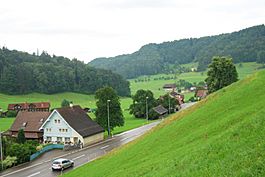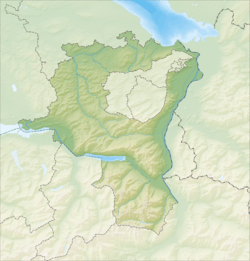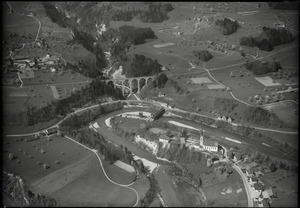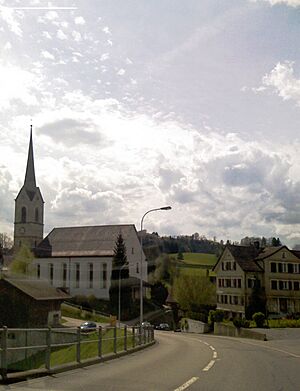Lütisburg facts for kids
Quick facts for kids
Lütisburg
|
||
|---|---|---|
 |
||
|
||
| Country | Switzerland | |
| Canton | St. Gallen | |
| District | Toggenburg | |
| Area | ||
| • Total | 14.1 km2 (5.4 sq mi) | |
| Elevation | 580 m (1,900 ft) | |
| Population
(Dec 2020 )
|
||
| • Total | 1,614 | |
| • Density | 114.5/km2 (296.5/sq mi) | |
| Postal code |
9604
|
|
| Surrounded by | Bütschwil, Degersheim, Ganterschwil, Jonschwil, Kirchberg, Neckertal, Mosnang, Oberuzwil | |
Lütisburg is a small town, also called a municipality, in Switzerland. It is located in the Toggenburg area within the canton of St. Gallen.
Contents
History of Lütisburg
Lütisburg was first written about in the year 1214. Back then, its name was Liutinsburch. Other smaller parts of the area were mentioned even earlier. For example, the tiny village of Rindal was noted in 849 as Runtal. Tufertschwil was first mentioned in 928 as Turolveswilare, and Alenschwanden also appeared in records in 928 as Waleessvanton.
Geography of Lütisburg
Lütisburg covers an area of about 14 square kilometers (which is about 5.4 square miles). A big part of this land, about 58.4%, is used for farming. Forests cover another large part, about 34.4%. The remaining land is used for buildings and roads (5.2%) or is made up of rivers and lakes (2.1%).
The town is built on a rocky hill. This hill is located where two rivers, the Thur and the Neckar, meet. Lütisburg includes the main village on the hill. It also has several smaller villages, called hamlets. These include Tufertschwil, Ober- and Unterrindal, Winzenberg, Rimensberg, Grünhügel, Gonzenbach, Schauenberg, Haslen, Dottenwil, Altegg, Wildenhof, Herrensberg, and Chrummentürli.
Lütisburg's Coat of Arms
A coat of arms is like a special symbol or logo for a town or family. Lütisburg's coat of arms has a golden background. On it, there is a black castle with a guard standing in front of its entrance.
People of Lütisburg
Lütisburg has a population of about 1,400 people. A small part of the population, about 8.2%, are people from other countries. Most people in Lütisburg, about 93.8%, speak German. Other languages spoken include Albanian (2.2%) and Serbo-Croatian (1.3%).
Age Groups in Lütisburg
In Lütisburg, about 16.1% of the people are children aged 0 to 9 years old. Teenagers, aged 10 to 19, make up about 19.6% of the population. Adults aged 20 to 59 make up a large part of the population. Older adults, aged 60 and above, make up about 13.3% of the population.
Education in Lütisburg
Most people in Lütisburg are well-educated. About 67.6% of adults aged 25-64 have finished high school or gone on to higher education, like a university.
Population Changes Over Time
Here's how Lütisburg's population has changed through the years:
| year | population |
|---|---|
| 1803 | 1,070 |
| 1850 | 1,285 |
| 1900 | 1,270 |
| 1950 | 1,372 |
| 2000 | 1,395 |
Religion in Lütisburg
Based on information from the year 2000, about 48% of the people in Lütisburg are Roman Catholic. Another 35.6% belong to the Swiss Reformed Church. Some people also belong to other Christian churches, including the Orthodox Church. About 4% of the population is Islamic. A small number of people do not belong to any church or did not share their religious beliefs.
Transport in Lütisburg
Lütisburg has a train station called Lütisburg railway station. It is on the Wil–Ebnat-Kappel train line. This line connects the towns of Wattwil and Wil. The station is part of the St. Gallen S-Bahn network, which is a local train system.
Special Sights in Lütisburg
The village of Lütisburg is recognized as a special place in Switzerland. It is part of the Inventory of Swiss Heritage Sites. This means it has important historical or cultural value that should be protected.
Economy of Lütisburg
In Lütisburg, people work in different types of jobs.
- The primary economic sector involves jobs like farming and forestry. About 144 people work in this sector, with 63 businesses.
- The secondary sector includes jobs in manufacturing and construction. About 182 people work in this sector, with 29 businesses.
- The tertiary sector covers jobs in services, like shops, schools, and healthcare. About 277 people work in this sector, with 43 businesses.
Many people who live in Lütisburg also travel to other towns for work. Similarly, some people from other towns come to Lütisburg to work.
See also
 In Spanish: Lütisburg para niños
In Spanish: Lütisburg para niños







